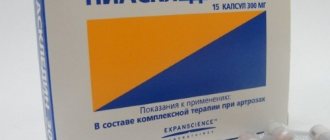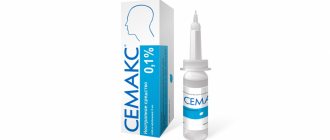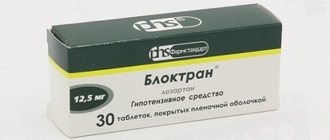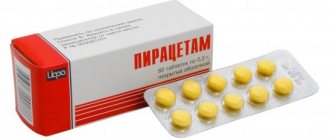There are many drugs that are used to normalize blood pressure. Physiotens is one of them. Next, you will learn how Physiotens works, how to use it correctly, what contraindications and side effects it has.
Hypertension is a pathology that is gaining more and more momentum every day. The reasons for this factor are different sources - these are stressful conditions, unhealthy diet, intense rhythm of life. This factor cannot be ignored. After all, hypertension can be life-threatening and cause death due to severe complications. In pharmacies you can find various pills to alleviate the patient’s condition. Physiotens tablets have an effective effect, reducing blood pressure to normal levels if you choose the right dosage for the patient. Next, we will study their instructions in detail.
Composition and release form
| Film-coated tablets | 1 table |
| moxonidine | 0.2 mg |
| excipients: lactose monohydrate - 95.8 mg; povidone - 0.7 mg; crospovidone - 3 mg; magnesium stearate - 0.3 mg; hypromellose - 1.3 mg; ethylcellulose - 4 mg; macrogol 6000 - 0.25 mg; talc - 0.9975 mg; iron oxide red (E172) - 0.0025 mg; titanium dioxide (E171) - 1.25 mg |
14 pcs in blister; There are 1, 2 or 7 blisters in a box.
| Film-coated tablets | 1 table |
| moxonidine | 0.3 mg |
| excipients: lactose monohydrate - 95.7 mg; povidone - 0.7 mg; crospovidone - 3 mg; magnesium stearate - 0.3 mg; hypromellose - 1.3 mg; ethylcellulose - 4 mg; macrogol 6000 - 0.25 mg; talc - 0.975 mg; iron oxide red (E172) - 0.025 mg; titanium dioxide (E171) - 1.25 mg |
14 pcs in blister; There are 1, 2 or 7 blisters in a box.
| Film-coated tablets | 1 table |
| moxonidine | 0.4 mg |
| excipients: lactose monohydrate - 95.6 mg; povidone - 0.7 mg; crospovidone - 3 mg; magnesium stearate - 0.3 mg; hypromellose - 1.3 mg; ethylcellulose - 4 mg; macrogol 6000 - 0.25 mg; talc - 0.875 mg; iron oxide red (E172) - 0.125 mg; titanium dioxide (E171) - 1.25 mg |
14 pcs in blister; There are 1, 2 or 7 blisters in a box.
Physiotens: Russian analogues
Physiotens, in addition to providing first aid for hypertension, also has a positive effect on the heart muscle. With long-term use, blood flow in the capillaries is restored. The drug is produced in Germany; there are also analogues of this product in Russia.
Analogue of Physiotens
Analogues of Physiotensa made in Russia:
- Moxonidine - C3, Moxonidine-Akrikhin, Moxonidine-Canon
- Felotens, Moxonidine, Moxonidine-Avexima, Moxarel.
Pharmacodynamics
Selectively interacting with imidazoline I1 receptors located in the brain stem, it reduces sympathetic activity.
Moxonidine has a high affinity for imidazoline I1 receptors and only slightly binds to central alpha2 adrenergic receptors due to interaction with which dry mouth and sedation are explained.
Reduces tissue resistance to insulin.
Effect on hemodynamics: a decrease in systolic and diastolic blood pressure with single and long-term use of moxonidine is associated with a decrease in the pressor effect of the sympathetic system on peripheral vessels, a decrease in peripheral vascular resistance, while cardiac output and heart rate do not change significantly.
Physiotens: is it possible to split the tablet?
Most often, the tablet is split to get a smaller dosage or to save money. After all, a drug with a higher dosage, if used in half a tablet, will be cheaper than buying the required dosage. Physiotens can be divided in half.
During the research, scientists found that there were no problems with dividing blood pressure medications. This was established after a survey of 1618 patients. Only 4 percent of respondents said that the effect of taking half a tablet reduced the quality of their condition.
Pharmacokinetics
Suction
Absorption - 90%. Cmax in blood plasma (after taking a tablet containing 0.2 mg moxonidine) is 1.4–3 ng/ml and is achieved after 60 minutes. Bioavailability - 88% (food intake does not affect pharmacokinetics).
Distribution
Volume of distribution - 1.4–3 l/kg. Penetrates through the BBB. Plasma protein binding - 7.2%.
Metabolism
Main metabolites: 4,5-dihydromoxonidine and guanidine derivatives.
Removal
T1/2 of moxonidine and metabolites is 2.5 and 5 hours, respectively. Within 24 hours, more than 90% of moxonidine is excreted by the kidneys, approximately 78% unchanged and 13% as a dehydrogenated derivative. Less than 1% is excreted in feces. Does not accumulate with prolonged use.
Pharmacokinetics in old age
Age-related changes in pharmacokinetics are observed, probably associated with slightly higher bioavailability and/or reduced metabolic activity. However, these changes are not clinically significant.
Pharmacokinetics in renal failure
Moxonidine excretion is significantly correlated with creatinine clearance. In patients with moderate renal failure (Cl creatinine in the range of 30–60 ml/min), equilibrium plasma concentrations and final T1/2 are approximately 2 and 1.5 times higher than in patients with arterial hypertension with normal renal function (Cl creatinine >90 ml/min). In patients with severe renal failure (Cl creatinine <30 ml/min), steady-state plasma concentrations and final T1/2 are 3 times higher than in individuals with normal renal function. The administration of multiple doses of the drug does not lead to accumulation in the body of patients with moderate renal failure. At later stages, in patients with extremely severe renal failure (Cl creatinine <10 ml/min) on hemodialysis, steady-state plasma concentrations and final T1/2 are 6 and 4 times higher, respectively, than in patients with normal renal function. In patients with impaired renal function, the dosage should be adjusted individually. Moxonidine is excreted to a small extent during hemodialysis.
How to take Physiotens correctly: under the tongue or with water?
When taking Physiotens, it is recommended to monitor your blood pressure and measure your pulse. To eliminate the manifestations of the disease, beta-adrenergic receptor blockers are taken along with Physiotens. If the patient needs to stop taking Physiotens, then first stop taking the blockers, and then the drug itself.
Rules for taking Phytosiotens
According to the instructions, the pills should be taken with water, but if a more effective effect of the tablets is required, then it is better to dissolve the tablet under the tongue. The active substances will penetrate the bloodstream, which significantly accelerates the normalization of blood pressure in patients. Use this method of taking the drug when a person’s blood pressure is too high.
IMPORTANT : Physiotens can be taken regardless of meal time. The required level of the main substance of the drug is achieved when only seven percent of moxonidine binds to plasma protein molecules. The highest level of the chemical component is recorded after 1.5-2 hours. The medicine comes out through the kidneys.
Interaction
Possible combined use with thiazide diuretics, ACE inhibitors and slow calcium channel blockers. There is a mutual enhancement of action when used together with these and other antihypertensive drugs.
There is no pharmacokinetic interaction with hydrochlorothiazide (combined use is possible), glibenclamide (glyburide), digoxin. Tricyclic antidepressants may reduce the effectiveness of centrally acting antihypertensive drugs (co-administration is not recommended). Moderately enhances reduced cognitive performance in patients taking lorazepam. Strengthens the sedative effect of benzodiazepines. There is no pharmacodynamic interaction when co-administered with moclobemide.
How long can you take Physiotens without a break? Can you drink it on an ongoing basis?
Physiotens, as already mentioned, should be used by patients in small dosages. Otherwise, various side effects may occur. You will need to strictly monitor your pill intake and evaluate your condition, especially with long courses of taking the medication. You can take Physiotens for a long time, but on the condition that you measure your pulse and blood pressure several times daily.
The drug is used if the patient has type 2 or 3 hypertension; before use, consult your doctor about the dosage of the drug. The cardiologist must prescribe a comprehensive treatment regimen. Hypertension cannot be treated with Physiotens alone. A specialist doctor should also stop taking pills. This will take two weeks; you will again need to monitor your pulse and blood pressure.
Overdose
Symptoms: headache, sedation, drowsiness, excessive decrease in blood pressure, dizziness, general weakness, bradycardia, dry mouth, vomiting, fatigue and stomach pain. A short-term increase in blood pressure, tachycardia, and hyperglycemia are potentially possible.
Treatment: Alpha-adrenergic antagonists may reduce or eliminate paradoxical hypertension. In case of hypotension, it is recommended to restore bcc through fluid administration and dopamine administration. Bradycardia can be relieved with atropine. There is no specific antidote.
Physiotens or Moxonidine or Capoten: which is better, more effective?
It is impossible to say which drug is better for a particular patient. After all, people have different perceptions of different types of tablets. For some, Physiotens is not suitable at all, and for others, Capoten is not suitable. But if we judge the effectiveness of the drugs in general, then Physiotens and Moxonidine still have a better chance of success. The effect of using these drugs is stronger than that of Capoten. In addition to lowering blood pressure, the patient’s headache also stops hurting and his condition normalizes for a long time.
Capoten is a remedy that reduces blood pressure within 20-25 minutes, but its effectiveness lasts only six hours in a row. Therefore, hypertensive patients should always have Capoten in their first aid kit.
Kapoten - instructions for use
Capoten is suitable for patients with type 2 hypertension. It gently reduces the load on the heart and regulates the synthesis reaction in the adrenal glands. Moxidin and Physiotens are drugs with a similar active ingredient, so the tablets have the same effect.
The principle of action of Moxonidine
IMPORTANT : You cannot use blood pressure medications haphazardly and uncontrollably. This threatens irreparable harm to the patient’s body and worsening the condition. And if you decide to use the pills without consulting a doctor, then read the instructions carefully, pay attention to the rules of administration and contraindications.
special instructions
If it is necessary to cancel simultaneously taken beta-blockers and Physiotens, first cancel the beta-blockers and only after a few days - Physiotens®. During treatment, regular monitoring of blood pressure, heart rate, and ECG is necessary. You should stop taking Physiotens gradually. Patients with rare hereditary conditions of galactose intolerance, lactase deficiency or glucose-galactose malabsorption should not take this drug.
There is no data on the adverse effects of moxonidine on the ability to drive a car or operate machinery. There are reports of drowsiness and dizziness during treatment with moxonidine. This should be taken into account when performing the above steps.
Physiotens: contraindications, side effects
Each pharmaceutical drug has its own advantages and contraindications; it is these contraindications that patients should pay attention to when choosing this or that drug. It is better not to use Physiotens in patients of the following categories:
- for patients under 18 years of age
- women in an interesting position and breastfeeding
- with bradycardia, if the pulse is less than fifty beats
- the patient has a disease in the form of heart failure in all forms of its manifestation
- for kidney pathologies
- when you are allergic to a medicine.
The official instructions say that Physiotens should not be given to teenagers under 18 years of age, but sometimes doctors lower this threshold, recommending taking the pills as early as 16 years of age. It is prescribed to patients if they have allergic reactions to the actions of other pills.
Can pregnant women drink Physiotens?
There is another list of contraindications to the use of tablets on an ongoing basis. But you can take Physiotens once. These include:
- Problems with lactose absorption, glucose malabsorption.
- Liver failure, various other organ pathologies, since the drug has a negative effect on the liver.
- Raynaud's disease, Parkinson's disease, epilepsy.
It is recommended to use the medicine with caution or once and for depression. Doctors do not advise patients with low weight to take pills.
Physiotens: reviews of patients who took these tablets
Tatyana, 34 years old:
After the New Year, my mother’s blood pressure rose to 190/100. We tried giving the Capoten tablet under the tongue, but there was no result. They called an ambulance, but there were no cars, they promised to arrive in an hour. We didn’t want to waste time, so we went to the pharmacy, where the pharmacist advised us to take Physiotens. After taking these pills, my mother immediately felt better, within an hour the headaches went away and her blood pressure returned to normal. They called an ambulance but refused the call.
Nona, 46 years old:
I have been using the drug for almost two years as prescribed by my doctor. There is a whole treatment regimen prescribed there. According to the prescription, it must be consumed strictly in the morning, thanks to this my blood pressure is normal. I experienced no side effects. I am under the supervision of my doctor and have a cardiogram every three months. When taking such drugs for a long time, you should definitely monitor your heart rate, blood pressure and heart function.
Alexandra, 39 years old:
Towards the evening I had a headache, I took my blood pressure, the readings were 155/100 and my pulse was higher than normal. My mother advised me to take Physiotens, the smallest dosage. She had just these pills in her medicine cabinet. I drank it, after half an hour the headache stopped hurting, and my blood pressure returned to normal. But I felt some panic and dizziness. I was scared. After which I decided to try to sleep. In the morning I woke up, there were no more side effects, I felt completely healthy. I still advise you to pay attention to the instructions for the drug, it indicated side effects, and Physiotrenz is still better to use in patients with the second or third degree of hypertension, and not with pressure values like mine. Moreover, I experience such pressure extremely rarely. Consult your doctors before using such serious means to avoid harming yourself.
On our website you can also read articles on the topic of cardiovascular health:
- Magnesium B6 – instructions for use;
- Blood pressure norms for women and men after 50;
- What are the normal heart rates for people by age?
- Bisoprolol is a drug used for chronic heart pathologies;
- How to measure blood pressure correctly?











